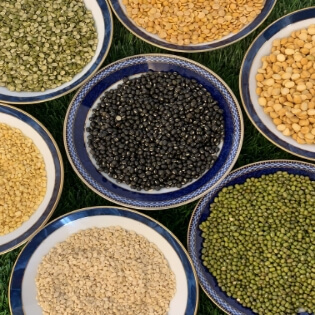COMMON TYPES OF DAL

Dals are an integral part of the Indian diet. A major source of protein, that the vegetarians use in their everyday meals. The variety of dals are endless.these Dals are commonly found among Indian Households
1. Toor Dal (Pigeon Peas)
- It is one of the essential dals, and it also goes by the name pigeon peas. Toor dal is an important source of protein and is a popular pulse not only in India, but in other parts of Asia. Toor Dal shows many antioxidant properties. This dal is a wise choice of protein for those with heart conditions.
Usually Used In Making
- Dal dishes like toor dal tadka, sambar, rasam, dal dhokli various other curries and gravies.
2. Chana Dal ( Split Chickpeas)
- It is used to make a lot of vadas and dal. This is another staple in every Indian household. This is also used in tempering many dishes. It is also essential for the heart as it is rich in antioxidants and reduces inflammation keeping the organ healthy. Those with high blood pressure should have chana dal daily. This dal is high in protein and rich in B - Complex Vitamins.
Usually Used In Making
- Dal Tadka, Dhokla, Ladoos and even chillas.
3. Green Moong (Whole Green Gram)
- These small oval green beans are a staple of Indian cuisine and no meal is complete without the addition of dal. Green Gram Dal has been cultured since antiquity, and India is the biggest producer of this legume. This adaptable legume, which retains great health, has a gentle, sweet taste that passes well.
Usually Used In Making
- Moong Sabzi, Soups, Salads, Dals, sprouts.
4. Yellow Moong Dal (Split And Skinned Green Gram)
- Moong Dal is split and skinned Green Gram Beans which is also known as Yellow Lentils. Moong dal is very healthy and easy to digest. You may add such as curry leaves, cumin seeds, black mustard seeds and asafoetida when making the dal. Yellow moong dal, when consumed under the daily recommended value, can be a part of your everyday diet as it has high protein content. It is a point to note that moong dal is rich in vitamins, carbohydrates, protein, etc. Therefore, it offers a good deal of health and skin-hair benefits.
Usually Used In Making
- Dals, curries, Halwa, Chilla
5. Split Green Moong (Split Green Gram)
- Mung beans are one of the best plant-based sources of protein. They’re rich in essential amino acids, antioxidants, and nutrients that may help reduce blood pressure, LDL cholesterol levels, and heart disease risk. Mung beans contain antioxidants such as vitexin and isovitexin that may protect against free radical damage that occurs during heat stroke.
Usually Used In Making
- Chillas, Dhokla, Khichdi, Dals
6.Urad Dal ( Split Black Gram )
- Urad dal is a good source of proteins, carbohydrates, lipids, iron, and calcium. Regularly eating urad dal with a low-fat diet may help maintain lipid homeostasis (balance). As a result, it may help reduce the risk of heart diseases. Agents responsible for this heart-friendly property of Urad dal are fibre, low glycemic index, and minor components like saponins, phytosterols and oligosaccharides. This dal is generally used in making medu vadas and many other vadas too.
Usually Used In Making
- Urad dal is a good source of proteins, carbohydrates, lipids, iron, and calcium. Regularly eating urad dal with a low-fat diet may help maintain lipid homeostasis (balance). As a result, it may help reduce the risk of heart diseases. Agents responsible for this heart-friendly property of Urad dal are fibre, low glycemic index, and minor components like saponins, phytosterols and oligosaccharides. This dal is generally used in making medu vadas and many other vadas too.
7. Black Urad Dal (Whole Black Grams )
- This simple lentil is full of iron, folic acid, calcium, magnesium and potassium, which makes this dal a perfect health package for pregnant women. It increases your bone mineral density, making your bones stronger and healthier as you grow older. It is very good for patients with diabetes as it regulates the glucose levels in the blood. It is good for your skin and can help fight dark spots, acne, and marks.
Usually Used In Making
- Dal, Curries, Sabzi
8. Masoor Dal (Red Lentils )
- Masoor dal laden with eye-friendly nutrients such as vitamins A, C and E is essential for maintaining a healthy vision and good eyesight. Masoor Dal is also highly beneficial for pregnant women as its iron and folate content helps in fetal development. The presence of dietary fiber, antioxidants, and protein, helps keep our blood pressure and cholesterol levels lower, thereby preventing the risk of heart disease.
Usually Used In Making
- Dals, curries, soup
- There are endless dals available in so many different sizes and colors. Interesting thing to know about legumes used in Indian cooking is that the same legume can be used in several different ways.


